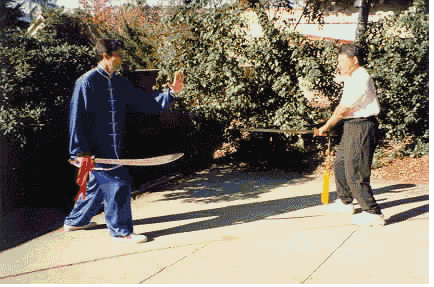|
Wu Dao (Single-Edged Blade e.g. Broadsword) vs. Straight Sword
The Dao (knife) can refer to any single-edged bladed weapon, but usually a broadsword. The broadsword is known as the "General" of ancient weaponry. Some think the straight sword is superior, and while the double-edged sword definitely has its advantages, the weight of the broadsword is a factor that cannot be ignored.
Both the broadsword and the straight sword are often practiced with one’s better hand, but interestingly enough there are disciplines that train switching hands as well as double-handed methods, and Wu Style is one of them. The advantage of switching hands promotes symmetry, and therefore, if done efficiently, could double the amount of strategies that could be employed.
The T’ai Chi Broadsword follows the principles of T’ai Chi including: peng, lu, ji, an, as well as other "jings. " It should come as no surprise then, that Zhong ding (or, central equilibrium) is essential in maintaining and utilizing the center to connect, neutralize, and redirect the opponent’s aggression (with or without a sword).
The Dao is an important weapon in Wu style. A demonstration video of the Wu style broadsword form is available at on-line store.
|
| Application: |
Nei Jia (Internal) kung fu |
|
Broadsword (Dao) against straight sword (Jian):

About Nei Jia kung fu
The approach of Taijiquan, Xingyiquan and Baguazhang is to engage the opponent's aggression, maintain contact and exploit the weaknesses in the opponent's situation.
More About Nei Jia (Internal) kungfu |
|

